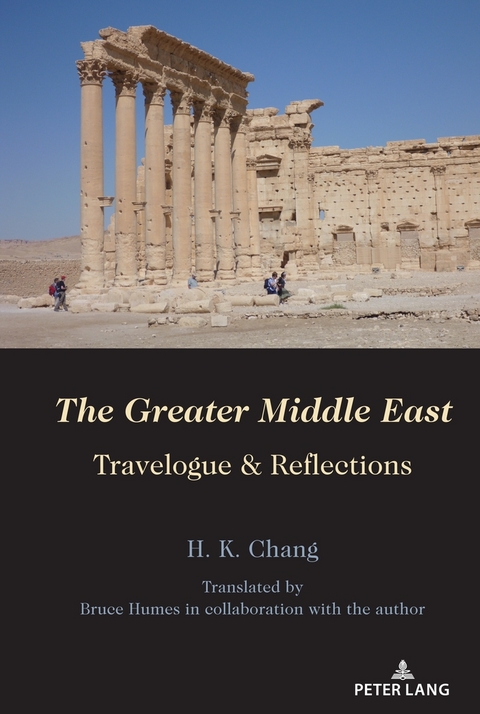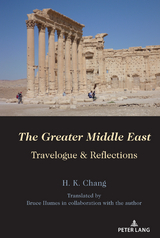The Greater Middle East
Peter Lang Publishing Inc (Verlag)
978-1-4331-7926-6 (ISBN)
Greater Middle East: Travelogue and Reflections is a history reader, cultural primer and notebook of a peripatetic rolled into a single volume. Raised in Taiwan and steeped in Chinese culture, Professor Chang set out on his self-styled "voyage across civilizations" from Gondar, Ethiopia, where his parents pioneered a medical center for WHO in the early 1960s.
Over the next five decades, he voyaged frequently. Two hard statistics are informative: 105 countries, 58 years. Based on his on-the-ground observations, he proposes the concept of a "Greater Middle East" that consists of 16 countries of the traditional Middle East, plus another 15 located on its periphery. Excepting Israel, the former are overwhelmingly Muslim, with Egypt to the west, Yemen and Oman to the south, Turkey to the north, and Iran to the east.
But his travelogue also takes us to the "fringes": North Africa’s Maghreb, whose fusion of pre-Islamic Berber roots and deep Muslim faith makes it unique; the four countries of the Horn of Africa where Asia meets Africa, particularly Ethiopia with its Orthodox Christian faith and Jewish Falasha; the Mediterranean’s Greece, Cyprus and Malta; and the hodge-podge of ethnicities and religions that inhabit the southern Caucasus—Armenia, Georgia and Azerbaijan.
Professor Chang is not an Arabist, an anthropologist or a travel writer along the lines of a sometimes-caustic Paul Theroux. Nor is he a European limited by a traditional Western education with its emphasis on Judeo-Christian values. While this travelogue is hardly a Chinese "take" on the Greater Middle East, it does benefit from the author’s firm grounding in East Asian culture and history. In particular, there are several "bonus" chapters documenting the impact of the Mongol Empire and nomadic culture of the Turkic peoples on the region, and this is something special—perhaps even unexpected—that you won’t find in your run-of-the-mill Middle East guidebook.
H. K. Chang is one of those rare personalities who first excelled in the hard sciences—he holds a Ph.D. in Biomedical Engineering from Northwestern University (USA) and was Dean of Engineering at the University of Pittsburgh—but went on to devote himself to the humanities, authoring 12 books on civilizations and education. Professor H. K. Chang was President of City University of Hong Kong from 1996 to 2007. He has been a visiting professor at the University of Paris, Cairo University, University of Delhi, Bilkent University in Ankara and Bosphorus University in Istanbul. An honorary professor at Peking University, Tsinghua University and others, he is a Foreign Member of the Royal Academy of Engineering (UK) and a Chevalier of France’s L’Ordre national de la Légion d’Honneur.
List of Figures – Introduction: Far from Quiescent Over Here – Ethiopia: Starting Point Out of Africa – Ethiopia: Proud Lion of the Horn of Africa – Eritrea: An Isolated and Ancient Country on the Southwestern Red Sea – Yemen: Turmoil in the Gulf of Aden – Somalia and Djibouti: The Turbulent Gulf of Aden – Sudan: A Glimpse of the Nile at Night – Four Countries of the Maghreb: Similarities Are Deceptive – The Maghreb: Couscous, Moorish Architecture and St. Augustine – Morocco: Where the Sun Truly Sets – Greece: Revisiting the Hellenic Republic Amidst the Debt Crisis – Greece: Classical Greek Culture and Western Learning’s Eastward Migration – Byzantium: The Roman Empire That Spoke Greek – Cyprus: Pawn in the Mediterranean – From Rhodes to Malta: The Saga of the Knights of St. John – Caucasus: Euro- Asian Borderline of Confrontation – Armenia: Scars of History – Georgia: Stalin’s Homeland – Azerbaijan: Of Poets and Petroleum – Egypt: On the Banks of Nile, at the Foot of the Pyramids – Egypt: From "Era of Ignorance" to "Egyptology" – Egypt: Center of the Arab World – Istanbul: Eternal Tulip Capital – Turkey: Continuous Cultural Revolution— Alaturka – Turkey: Call of the Mosque – Turkey— Joining the EU: Must Turkey Decouple with Asia? – Iran: After the Revolution – Iran: Pilgrimage to the Grand Cities of Persia – Iran— Which Does It Want: East or West? – Mesopotamia: Cradle of Human Civilization – Iraq: Birthplace of Urban Civilization – The Arabian Peninsula: Birthplace of Islamic Civilization – The Persian Gulf: Purchasing Modernization – Syria and Lebanon: Migrating Civilizations – Syria: Author, Teacher, Driver, President – Lebanon— Closer Observation: 21st- century Sequel to a Visit in the 60s – Jordan: Who Says a People Cannot Be the Masters of Their Own Destiny? – Israel: The Jewish State – Palestine: Conflicting Claims to Jerusalem – Israel and Palestine: One Land, Two Peoples and Three Faiths – Agricultural vs. Nomadic Lifestyles: "Clash" of Civilizations? – A Brief History of Nomadic Peoples and Eurasia – Monarchs and Monks: Emergence of a Class Society – Islam: A Brief Introduction – The Turkic- Speaking Peoples and Islam – The Mongolian Empire and Our Modern World – Key Events in the Greater Middle East – Index.
| Erscheinungsdatum | 15.01.2021 |
|---|---|
| Zusatzinfo | 10 Illustrations |
| Verlagsort | New York |
| Sprache | englisch |
| Maße | 150 x 225 mm |
| Gewicht | 606 g |
| Themenwelt | Reisen ► Karten / Stadtpläne / Atlanten ► Naher Osten |
| Reisen ► Reiseberichte ► Naher Osten | |
| Geisteswissenschaften ► Geschichte ► Regional- / Ländergeschichte | |
| ISBN-10 | 1-4331-7926-1 / 1433179261 |
| ISBN-13 | 978-1-4331-7926-6 / 9781433179266 |
| Zustand | Neuware |
| Informationen gemäß Produktsicherheitsverordnung (GPSR) | |
| Haben Sie eine Frage zum Produkt? |

